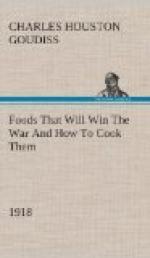* * * * *
Use all bits of bread, that cannot be used as toast, in puddings, croquettes, scalloped dishes or to thicken soup.
* * * * *
Don’t throw away cold muffins and fancy breads. Split and toast them for next day’s breakfast.
* * * * *
Foods that survive the earlier forms of waste are often lost at table by the serving of portions of like size to all members of the family. The individual food requirements differ according to age, sex, vocation and state of health. Each should be considered before the food is served, then there will be no waste on the plates when the meal is over. The following table, showing the daily requirement of calories for men and women in various lines of work, illustrates this point:
WOMEN CALORIES
Sedentary work ... 2,400
Active work ... 2,700
Hard manual labor ... 3,200
MEN CALORIES
Sedentary work ... 2,700
Active work ... 3,450
Hard manual labor ... 4,150
Although the serving of food should be carefully planned so as to prevent waste, care should be taken that growing children have ample food. It is a mistake to suppose that a growing child can be nourished on less than a sedentary adult. A boy of fourteen who wants to eat more than his father probably needs all that he asks for. We must not save on the children; but it will be well to give them plain food for the most part, which will not tempt them to overeat, and tactfully combat pernickety, overfastidious likes and dislikes.
The United States Food Administration is preaching the gospel of the clean plate, and this can be accomplished by serving smaller portions, insisting that all food accepted be eaten; by keeping down bread waste, cutting the bread at the table a slice at a time as needed; by cooking only sufficient to supply moderately the number to be fed, and no more. It is a false idea of good providing that platters must leave the table with a generous left-over. Waste of cooked food is a serious item in household economy, and no matter how skillfully leftovers are utilized, it is always less expensive and more appetizing to provide fresh-cooked foods at each meal.
One would think that with the various uses to which all kinds of foodstuffs may be put that there would be little left for the yawning garbage pail. But the Secretary of the United States Department of Agriculture is responsible for the statement that $750,000,000 worth of food has been wasted annually in the American kitchen. Undoubtedly a large part of this wastefulness was due to ignorance on the part of the housewife, and the rest of it to the lack of co-operation on the part of the employees who have handled the food but not paid the bills.
According to a well-known domestic scientist, the only things which should find their way to the garbage pail are:




